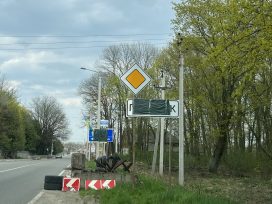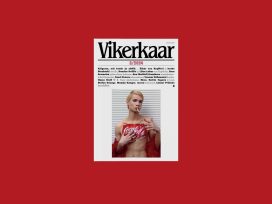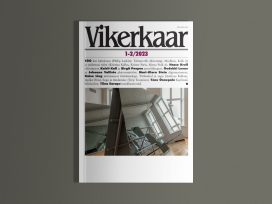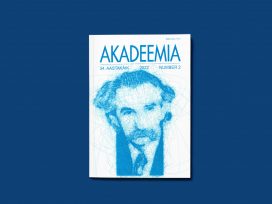Abandoning is both a tangible and intangible process.
It is about broken knowledge, about what no longer fits, about a mark between the old and the new. And yet the act of separation is neither neutral, nor is it free of affects, since the destruction or negligence of past things erodes the individual’s sense of belonging.
Waste and obsolescence are always categorized and generated within a particular frame of value, built in part on economic efficiency, but also on cultural representations, personal emotions and temporal regimes. Value is not inherent to things, but a circumstantial assessment that specific people create within a given context.
So what value does fixing have? And what do the social relationships of repair look like? The enactment of care is a matter of everyday interactions, manifested in the form of an affirmative micro-politics of kindness and welfare. Acts of repair make late-modern societies more balanced, kind, and stronger.
In the old-town of Tallinn, next to souvenir shops and fancy restaurants, one can find a tiny remont business. The very same business has been on Nunne Street since 1920, and it is the oldest of its kind in Estonia. The space barely measures two meters square. In it, a man repairs clocks, radios and cameras every week day from 12 to 4 pm. Toomas Koitmaa has been the owner since 1996. He has an apprentice, Dmitri, who finds it interesting ‘to learn different mechanisms and imagine the different lives of things’. They have considered making a remont of the remont place, but they cannot afford to do it. They are already struggling to keep the shop open everyday, as both Toomas and Dmitri have other jobs, where they earn their living.
For them, repairing broken things is both a hobby and a cultural experience. Sometimes they have to repair expensive items, at other times they just do some basic remont to keep a device working. ‘Rich people, middle-class and poor people come here. We attend to them all; for the poor people around the Railway Station, we often do the remont for free’, Dmitri explains.
Observing the variety of people coming to this tiny place, I realize that these clients do not simply belong to different social classes and bring different objects; they also seem to live in different temporalities and have different experiences of time and the configuration of past and future (i.e. obsolescence and duration).
In a way, post-socialist societies are like the clock shop where each clock shows a different time and ticks at a different speed. These differential relations over time and temporal representation organize and perpetuate inequalities. Indeed, repair practices are especially meaningful when the ordering sense of time is vanishing and changes extend social asynchronicity. In a society such as the Estonian one, which is conditioned by multiple disruptions, accelerated changes, inequality and pressure for aimless innovation, repair appears as a practice that establishes continuity, endurance and material sensitivity.
This argument may seem counter-intuitive; the imperative to mend imposed under the Soviet regime contrasted with the subsequent availability of cheap mass-produced goods; post-socialist practices of consumer citizenship seemed to signal the decline of repair. However, contemporary mending and the reluctance to dispose of material possessions can also be a way to resist dispossession and adapt to convoluted changes; the act throwing away is perceived as a threat to memory, to security, and to historical and ecological preservation.
In Estonia, the Soviet experience is often depicted as an unnatural and somehow unreal time. Indeed, 1991 appears as a year of massive obsolescence. Abandoned factories, rusting machinery, decaying buildings, chemically polluted zones, environmental catastrophes and industrial debris have for decades symbolized the collapse of the USSR – the disintegration of the regime in its literal and material sense.The recent past was reconstructed and remembered in the light of more recent events as an anti-paradigm, often with an ‘arrogant and disgusted attitude towards things emanating from the socialist era’. Not just forgetting, but remembering, too, involves the neglect of material evidence that recalls a past considered undesirable.
At the Tallinn Architectural Biennale of 2013 (‘Recycling Socialism’), experts discussed whether it was necessary, in order for society to ‘move on’, to demolish structures and buildings that represented Soviet ideology. In the attempt to construct a new tradition, Soviet landmarks were sacrificed. Indeed, we have seen impressive buildings torn down to make space for shopping malls. Other buildings linger in an unclear status or have been privatized.
All these cases illustrate the increasingly brief lives of buildings bought and sold for speculation purposes, as well as the actual politics of memory in Estonia. In a revanchist urban planning, Soviet era buildings are rapidly devaluated, are deemed unworthy of investment and, ultimately, expendable. The most recent case was the Ministry of Finance, built in 1978 by the architect Ülo Ilves to house the planning committee for computing. The building bore the first piece of public abstract art, created on its façade by the artist Edgar Viies.
The government’s original idea was to renovate the building; however, claims about the bad quality of the construction materials were made, and the real estate company eventually proposed demolishing the building and re-build it from scratch. In the end, a competition was held in 2015 for a new ‘Super Ministry’ office complex on the site (hosting four ministries on 14,420 meters sq.).
The architects’ union advocated preserving the historical building, calling it a valuable monument to its era. The artist Leonhard Lapin remarked that ‘the fact that the house was built during the Soviet occupation does not make it worthless’, while also noting that functional buildings can hardly last more than three decades in the centre of Tallinn.Another recent case of ‘official vandalism’ against the modernist legacy was the Central Post Office, which was subjected to a different sort of sacrifice (or afterlife). The Postimaja was built between 1977 and 1980 on the eve of the Moscow Olympics, during which Tallinn hosted the Olympic regatta in the Bay of Finland.
The building’s main function was to host postal and telecommunications services; long distance calls were also available through an operator on the first floor. A distinctive three-storey limestone construction replaced an old gas station, symbolically connecting the Rottermann quarter with the old-town and the Narva highway. Raine Karp (the architect behind Linnahall and the National Library) and Raigna Mati were in charge of its design.
The Central Post Office had the first escalator in Estonia; people came from all over the country to see and try it out. The escalator soon broke down and was replaced by a conventional staircase in 1988. Silver Agu was the person in charge of the repair and maintenance of the Postimaja between 1990 and 2001. He was very glad to recall details of his everyday work, showing photos and telling of the personal affection he developed for Postimaja. For him, to have worked in the Central Post Office was something to be proud of:
In its time, in the 80s, it was an elegant building. But now, surrounded by other buildings, like the hotel and the cinema, it loses its presence … In its original context the building was majestic, but when surrounded, it lost the perspective from which to view it.
Mail and telecommunication industries have gone through structural changes during recent decades, a phenomenon due primarily to the innovations brought by information technologies. The volume of traditional mail has been gradually declining. E-mail has killed the postal service, and by extension post offices.
As Liviu Chelcea shows in his ethnography of bank workers in Romania, economic transformations also brought about an acceleration in the experience of time – accompanied by the emergence of new routines, disciplines and standards, a sharper separation between work and life (alongside the colonization of personal time by the employer), and a diffuse long-term future where meaningful plans appear fantastical. This has led to significant changes in the organization of the economy and of culture, space and time, and is manifested in discourses of flexibility and ‘self-regulating selves’. A new category has emerged – the ‘old timers’. Each new employee is supposed to master and perform operations previously assigned to different employees. David Harvey has called this process the ‘accelerated destruction’ of prior skills in relation to processes of deindustrialization in the West. In her ethnography of an Estonian oil shale mine, Eeva Kesküla notes that the introduction of new technology was just as significant a breaking point in the history of the miners as the year 1991. What are the distinctive differences in this process of making the past system and skills obsolete? Katherine Verdery has remarked that changes in the experience of time have been crucial for the economic and political organization of post-socialist societies. Individuals had developed certain responses (e.g. hoarding) to the irregular and spontaneous socialist time that affected their daily lives; with the introduction of planned, standardized yet unequal capitalism time, people had to invent new ways of coping. Socialism is over but the remains are still here, as Svetlana Alexievich shows in her oral history of the post-Soviet legacy. Many who grew up in the USSR live in ‘second hand time’, an era of disenchantment. These are people out of history, left standing with nothing durable to counter surrounding societal changes. Still, we must coexist with them; those excluded from success nevertheless intrude onto our scheme of things from time to time, ‘polluting’ our sense of order.
These vignettes reveal that the vanquishing of the Soviet world happened on a different time scale than the neglect and decay of its legacy, allowing for new availabilities, intricate re-appropriations and unforeseen opportunities for reconciliation. The complexity of the obsolete and the abandoned is precisely that it does not vanish. It lingers on, shaping contemporary notions of the subject, of time, and of the world.
To be categorized as obsolete implies that one no longer has a use or purpose, lacks cultural distinction and has zero worth. In Estonia, people considered ‘superfluous’, ‘dispensable’ or ‘wasted’ are not migrants or asylum seekers (as in former empires), but those who fell into such a condition after the collapse of the previous order. We may even speak of a lack of pragmatic competence, pointing at the discrepancy between the speed of institutional reforms and the slowness of cultural changes, which become obstacles for personal development.‘Yes, they all were great people. I’m particularly thankful to Madis, who hired me when I most needed a change’, admitted Ljuda. And yet the change she refers to heralded a step back to the past. Ljuda (a Russian speaker) studied typography in Riga in 1968, completing four years of training. In 1972, she moved to Tallinn to work at the Ühiselu printing house, the oldest in Estonia. In 2002, Ühiselu merged with Reusner publishers, and older workers were demoted to mechanical work such as supplying paper to newly imported machines and producing cheap books. ‘I consider typography an art’, Ljuda adds. From being a discarded worker, she became a worker of the discarded, giving a new life to the letterpress printing-machines gathered by Madis Mikkor and his gang at the Polymer culture factory, a DIY-space for artists in central Tallinn.
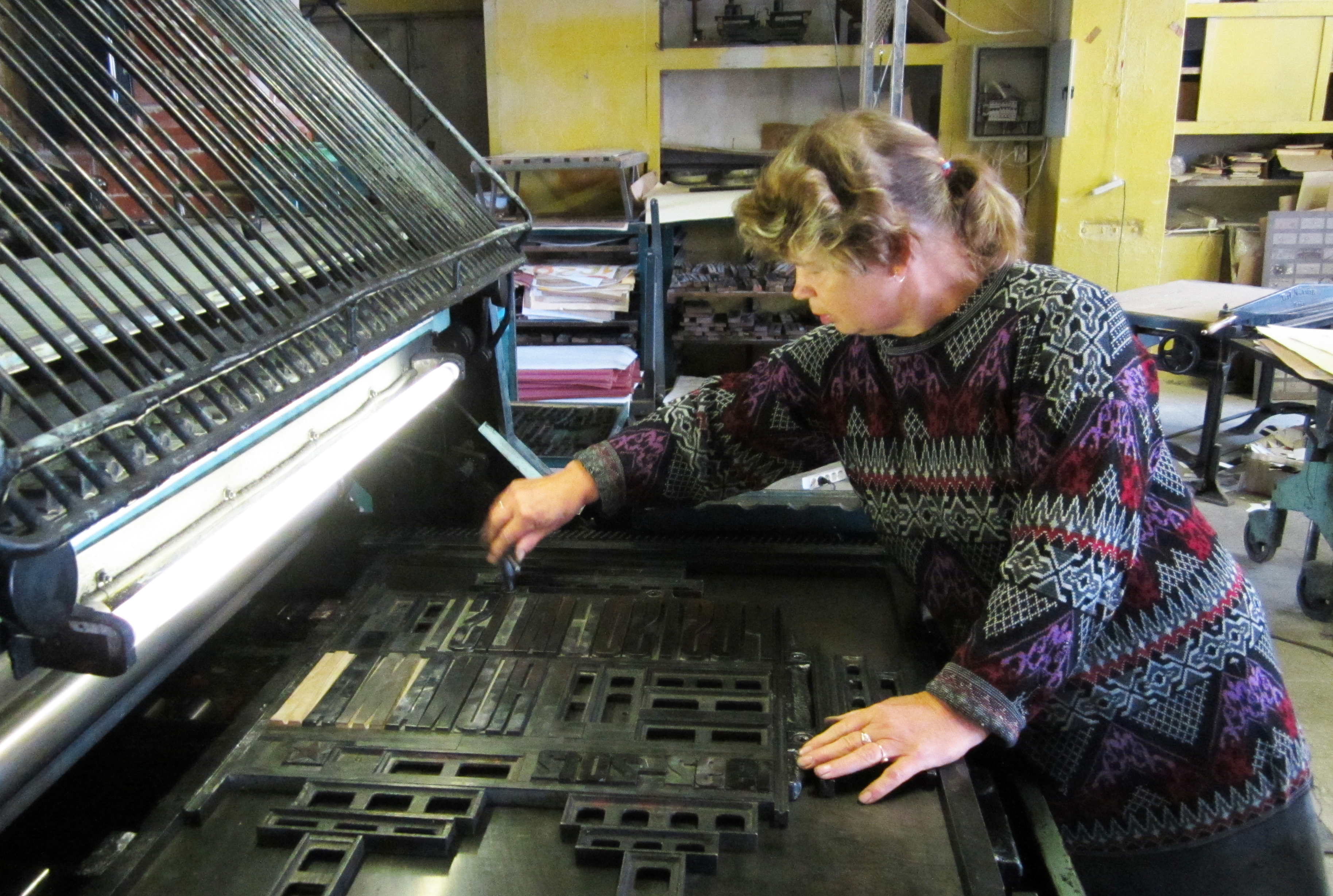
Ljuda working in Polymer. Photo: Francisco Martínez
More than forty years after her training, Ljuda was still willing to print posters and visiting cards. She worked at Polymer until it closed down in 2014. She also conducted workshops to students of the Estonian Academy of Arts and taught the profession to Lemmit Kaplinski. ‘Ljuda is a phenomenon bigger than herself,’ he says. ‘Forty years ago there were hundreds of Ljudas, nowadays she’s the only compositor, somehow saving a secret knowledge. The case of Ljuda shows that people are affected by technological change in an identitary way. Losing her job in the early 2000s meant losing her identity, being just half a part of herself or something like that. It is important to remember this matter in contemporary societies. I do not mean that changes are bad, just that we have to be aware of the human aspect too.’
Ljuda is conscious of that; she repeated on several occasions that she remains ‘the only person in Estonia who knows this art deeply. My former colleagues left the profession in the nineties and the new generations don’t want to get dirty.’ Retirement did not force Ljuda to quit her profession; it is unconceivable for her to stop doing typography. Printing helps her to negotiate changes that elude her comprehension and render her skills obsolete.
In the USSR, labour had a strong subjective dimension; people often built their identities upon their job. In post-socialist societies, however, technological innovation, the neo-liberal economy and discourses of flexibility and the enterprising self caused the disappearance of workplace identity, compelling people to take individual responsibility for collective risks.
There was a different material attentiveness in Soviet society; repair was particularly praised in a context of shortage and mass production, in which planned obsolescence and competition, both essential to a market economy, had no role. This attentiveness also related to particular skills that are not appreciated in an economic system that relies on accelerated cycles of production-consumption-disposal and rapid financial profit. Once Polymer was closed, printing artefacts were brought to Tartu and placed in the Printing Museum, founded in 2010 as a NGO. ‘I was originally involved because of emotional reasons,’ remarks Lemmit Kaplinski.‘I like the shape, sound and smell of these machines. Also, I believe that innovation stems from the understanding of old technologies. We can learn from them the basic rules and get past dead end solutions.’
Every year, the Printing Museum invites Ljuda to spend some days teaching and getting dirty on the machines in Tartu. Lemmit’s favorite artefact is the linotype (line casting machine), produced in Leningrad in 1972. In the tour through the museum, surrounded by all kinds of discarded artefacts, I felt a sort of obsolescence vertigo. It was like a tour into the intestine of the twentieth century. The obsolete is also a carrier of memory.
As Lemmit observes, ‘it is possible to see the recent history of this country by observing the changes in printing. For instance, WWII marks a cleavage. Before then, all the machines were produced in Germany; after that, they were produced in the Soviet bloc. Since printing was about communicating ideas, the authorities closely checked the profile of people learning the profession in the Soviet period; printing was not simply a magical process, but had strong political effects too.’
One challenge, however, is that rapid obsolescence blocks our access to the past, in that we become incapable of using these technologies and reading old files; our way of experiencing and thinking is increasingly shaped by new interactions with new kinds of media. The material culture of the Soviet world risks being lost due to the decreasing knowledge of how the materials of this past work (as well because of their entropic degradation).‘The 1990s affected the printing industry in major ways. Publishers could access modern equipment if they found the financial means. But the changes happened so quickly that that people did not care about preserving industrial heritage. What you see here are the few things left. They help to preserve memory’, Lemmit concludes.
In 2014, the museum was relocated to Aparaaditehas, a former military factory that has been bought by the same group that developed the Telliskivi area in Tallinn (which also transformed a military factory into a commercial area with space for cultural events). The museum is over 240 meters square and conserves the original lamps of the military factory. Seven people are involved with different sorts of work; the books used at the printing museum were collected for free from state libraries, which discarded tons of them every year.
There, we meet Kaarel Narro, a young carpenter who works in one of the basements of the courtyard. Kaarel’s work space confirms his kind of low status within Estonian society, yet also gives a very personal character to the place, all of which is manifested by the physical layout of things; his values are expressed through his material domains. ‘From trash, and with trash, I have produced my little studio’, says Kaarel, who pays a symbolic price for renting the basement. This is an inhabited working space, in which the objects are ordered according to the needs of the work carried out there. Kaarel has organized the 25 square metres. into two rooms, arranged according to the different kinds of skilled work he has to do. Everyday his body encounters the material world to fix different kind of brokenness. Aggregations of dust, pieces and varied scraps also lay around, in a way that it is hard to figure out if they were already there before, or are off-cuts from Kaarel’s work. ‘I forced the manager to rent this basement to me. Originally, they didn’t know what to do with the space, so I insisted and asked Lemmit to mediate. Some dynamism has now started in Aparaaditehas; I guess they could have rented this space for more money; or perhaps I am also working as a catalyst, making this area more attractive’, jokes Kaarel.
Kaarel’s hands are cracked, callused and rough. Yet during our conversation, he appears unexpectedly delicate, vulnerable and charismatic; thinking carefully what to say, taking time to answer, measuring every word.
Repair is a form of re-enactment accompanied by emotional and bodily investment. Not surprisingly, craftsmen take most pride in skills that mature and evolve (later I learn that Kaarel is also a musician). He complains that ‘Estonia has become a throwaway society … people cannot control the instinct of possessing. Before, people possessed the stuff they need to survive, and not always. Nowadays it is excessive, and people possess and consume just for the sake of it. … In my view, there is some arrogance with newness.’
According to Kaarel, there is not enough communication between generations: ‘one of the things I like about the printing museum is that people of different ages gather there’, he adds. Paradoxically, repair activities foreground historical connectivity and bind different generations together, as attempts to synchronize – both bodily and temporally – asynchronous forms of community. For Kaarel, repair is a form of being in time, part of a work of adaptation, a relational world-building.
Thomas Hylland Eriksen describes the last twenty-five years as a period of ‘overheating’, calling attention to the accelerated change and the heightened level of activity in the realms of economy and communication. Suddenly, from two-speed societies, we have entered a turbo-world of asymmetrical forces and out-of-sync experiences. causing the multiplication of entropic side-effects and an anxious and fragmented co-existence of multiple temporalities. And yet, what distinguishes contemporary society is the conscious knowledge of obsolescence. In order to illustrate the existence of competing temporal vectors around us, I went to talk to Arno Pihl, who has been in charge of the maintenance of technological devices at Tallinn University since its foundation in 2005. At the time, all devices were analogue, whilst nowadays they are almost all digital. For Arno, this change has meant more responsibilities: as there are more technologies surrounding us, more repair is needed and the technician has to continuously learn and update himself.
Arno earned a certificate in the Soviet era as a mechanic: ‘At the time there was not even MS-2 operating system’, he says. Ten years ago, he spent his time to making sure that projectors, computers and microphones were working. Nowadays, half of his time goes to repairing broken devices. He is also in charge of multimedia, ‘as they call it’. Arno explains: ‘I have to multitask, but I would not say I work more than ten years ago. It is just different’.
On the walls of Arno’s atelier there are magnets which hold the tools; a bell hanging from the roof, ringing in the wind of a ventilator; dozens of mice and dismantled computers; old radios and speakers; and cables, many cables hanging. ‘You can take pictures of the stuff, but if the rector sees what I have here he will ask me to throw all this stuff away.’ And why do you keep all this here? ‘Because anytime I could need one of these pieces. You know, every year there is more bureaucracy to order anything and I don’t have my own budget. If I want to buy a tool, I have to fill half a dozen of documents. Ah euro-norms! … But I select a lot. I just keep one third of the stuff that comes to my hands. I think in perspective: what could be of use in the future?’
Arno insists in instilling in people the need to think more in perspective and reflects on the transition from durable goods to disposable ones: ‘In Soviet times, it was all about accumulating stuff; and now it is about throwing away. I’m for a middle way … nowadays, technologies get old very fast, but the skills of a mechanic last longer.’
According to Arno, there is a hierarchy of qualities among devices: the best are made in Japan, the worst made in China. Even so, nowadays it is more difficult to know where the product has been produced, since there are different pieces produced and assembled in varied places. ‘Products from Japan were possible to repair. Nowadays, all have an in-built obsolescence and stop working after two years, the minimum to respect the warrant. Once they break up, it is truly better to buy a new one, because the device is not worth repairing’. Arno emphasizes that he is not in favour of a society of consumption, but that he observes a regression in the performance of technological devices. Things are not designed for repairability anymore: ‘In the European era, the quality of products has decreased, because it is not always clear who is responsible for making the thing’.
Accelerating cycles of acquisition and disposal, as well as technological changes, require a deeper attention to repair and obsolescence. These highlight the effects of social change and give insight into cultural values. Repair helps people overcome the negative logic that accompanies the abandonment of things and people, recalibrating synchronicity and a sense of commonality. This practice has consequences for how we think of social relations, by lending continuity to discontinuity and demonstrating care and recognition. Social tensions are alleviated through the recovering of things, helping to sustain a sense of belonging and duration, reconnecting personal biographies to public and private materiality. We can situate repair as part of the everyday micro-powers, those which contribute to creating transcendental narratives of reconstitution after wrongdoing or abandonment.
